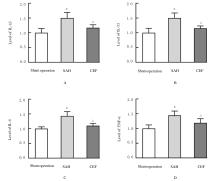吉林大学学报(医学版) ›› 2021, Vol. 47 ›› Issue (6): 1462-1468.doi: 10.13481/j.1671-587X.20210616
头孢曲松对蛛网膜下腔出血大鼠星形胶质细胞活化和炎症反应的影响
- 1.华北理工大学临床医学院实验中心,河北 唐山 063000
2.华北理工大学附属医院神经外科,河北 唐山 063000
Effects of ceftriaxone on activation of astrocytes and inflammation reaction in rats with subarachnoid hemorrhage
Zehua GONG1,2,Junjie LIU1,2,Jiwei XU2,Jianmin LI1,2( )
)
- 1.Experimental Center,College of Clinical Medicine,North China University of Science and Technology,Tangshan 063000,China
2.Department of Neurosurgery,Affiliated Hospital of North China University of Science and Technology,Tangshan 063000,China
摘要: 探讨头孢曲松(CEF)对蛛网膜下腔出血(SAH)大鼠的神经保护作用,并阐明其可能的作用机制。 将48只清洁级雄性SD大鼠随机分为假手术组、SAH组和CEF组,每组16只。采用改良后的血管内穿刺法制备SAH大鼠模型,CEF组大鼠术前5 d开始腹腔注射给药,药物剂量为200 mg·kg-1。模型建立24 h后,对各组大鼠进行神经功能评分,HE染色法观察各组大鼠脑组织神经细胞形态表现并计算其神经细胞坏死数,免疫组织化学染色检测各组大鼠脑组织中星形胶质细胞的活化数,ELISA法检测各组大鼠脑组织中白细胞介素1β(IL-1β)、白细胞介素33(IL-33)、白细胞介素6(IL-6)和肿瘤坏死因子α(TNF-α)水平。 与假手术组比较,SAH组大鼠组神经功能评分明显降低(P<0.05);与SAH组比较,CEF组大鼠神经功能评分明显升高(P<0.05)。HE染色,假手术组大鼠神经细胞分布排列有序、形态规整,细胞匀称,细胞核居中,染色清楚;SAH组大鼠的神经细胞排列杂乱,形态不规则,呈锥状,胞核收缩、破裂和溶解;CEF组大鼠脑组织神经细胞结构较完整,胞核固缩减轻。与假手术组比较,SAH组大鼠神经细胞坏死数明显增加(P<0.05);与SAH组比较,CEF组大鼠神经细胞坏死数明显减少(P<0.05)。免疫组织化学染色,活化的星形胶质细胞形态多呈“分支状”,细胞体较小,以细胞质染色为主,突起增粗延长且长短不一。与假手术组比较,SAH组大鼠星形胶质细胞活化数明显增多(P<0.05);与SAH组比较,CEF组大鼠星形胶质细胞活化数明显减少(P<0.05)。ELISA法检测,与假手术组比较,SAH组大鼠脑组织中IL-1β、IL-33、IL-6和TNF-α水平明显升高(P<0.05);与SAH组比较,CEF组大鼠脑组织中IL-1β、IL-33、IL-6和TNF-α水平明显降低(P<0.05)。 CEF能够减轻SAH大鼠脑组织神经细胞的坏死,提高大鼠神经功能评分,具有神经保护作用,其机制可能与抑制星形胶质细胞活化和减轻炎症反应有关。
中图分类号:
- R743.35






